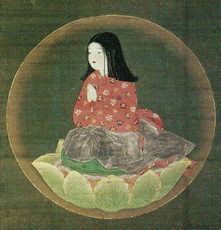An Illustrated Outline of Buddhism: The Essentials of Buddhist Spirituality (34 page)
Read An Illustrated Outline of Buddhism: The Essentials of Buddhist Spirituality Online
Authors: William Stoddart,Joseph A. Fitzgerald
Tags: #Philosophy


113
(20) Japan
i. The Introduction of Buddhism into Japan
Buddhism was first introduced into Japan from the Korean kingdom
of Paekche (Kudara) during the Asuka Period (sixth century A.D.) by
Shōtoko Taishi, regent of his aunt, the Empress Suiko. The exact date
is traditional y said to have been 552 A.D. The magnificent early Bud-
dhist works of art in the seventh century monastery of Hōryū-ji, near
Nara in Japan, are considered to have been produced by Korean sculp-
tors and craftsmen as well as by their Japanese pupils.
It is remarkable how rapidly the transmission of Buddhist teach-
ings over immense distances could take place. For example, the Indian
master of the
Vajrayāna
school, Vajrabodhi, arrived in China in 720
A.D. His chosen disciple was Amoghavajra (Pu-k’ung), and the lat-
ter’s primary successor was the Japanese Kōbō Daishi (Kūkai), who
returned to Japan at the beginning of the ninth century, where he
founded the Shingon sect. All this (from India, via China, to Japan)
happened within the space of about 80 years.
The Japanese historical periods are shown on the next page.
The priest Kōbō Daishi as a child, Japan, 14th century
Make the practice of
Nembutsu
[
the invocation of the saving
Name of the Buddha
]
the chief thing in life. Lay aside everything
that may interfere with it.
Hōnen

114
An Illustrated Outline of Buddhism
ii. The Japanese Periods
600 B.C.
Foundation of the Japanese Empire by
Jimmu Tennō
600 B.C.-c. 250 B.C.
Jōmon Period
c. 250 B.C.-c. 250 A.D. Yayoi Period
c. 250 A.D.-c. 552 A.D. Kofun Period
552 A.D.-645 A.D.
Asuka Period
645 A.D.-794 A.D.
Nara Period
645 A.D.-710 A.D. Hakuhō Period
711 A.D.-794 A.D. Tempyō Period
794 A.D.-1185 A.D.
Heian Period
794 A.D.-897 A.D. Jōgan Period
898 A.D.-1185 A.D. Fujiwara Period
1185 A.D.-1333 A.D. Kamakura Period
1333 A.D.-1392 A.D. Nambokuchō Period
1392 A.D.-1568 A.D. Muromachi Period
1568 A.D.-1615 A.D. Momoyama Period
1615 A.D.-1868 A.D. Edo Period
1615 A.D.-1688 A.D. Early Edo Period
1688 A.D.-1764 A.D. Middle Edo Period
1764 A.D.-1868 A.D. Later Edo Period
1868 A.D.-present
Modern Japan
1868 A.D.-1912 A.D. Meiji era
1912 A.D.-1926 A.D. Taishō era
1926 A.D.-present Shōwa era


Japan
115
iii. A Selection of Haiku (Japanese 17-syllable Poems)1
My ears had found the sermon dull and stale;
But in the woods outside—the nightingale!
Masaoka Shiki
(1866-1902)
Without a word of warning, look, alone
Above the autumn clouds, Mount Fuji’s cone!
Kamijima Onitsura
(1660-1738)
O timid snail, by nature weak and lowly,
Crawl up the cone of Fuji slowly, slowly. . . .
Kobayashi Issa
(1763-1827)
Between the washing-bowls at birth and death,
All that I uttered: what a waste of breath!
Kobayashi Issa
(1763-1827)
I have seen moon and blossoms, now I go
To view the last and lovliest: the snow.
Rippo
(1600-1669)2
1 From
A Net of Fireflies
,
translations by Harold Stewart (Rutland, Vermont, and Tokyo, Japan: Charles E. Tuttle Company, 1960).
2 Written by the poet on his death-bed. Moon and blossoms are forms. The snow is
pure Substance.

116
An Illustrated Outline of Buddhism
iv. The Sects of Japanese Buddhism
The Japanese masters Dengyō-Daishi (Saichō) (767-822) and Kōbō
Daishi (Kūkai) (774-835) were acquainted with each other, but of dif-
fering perspectives. Both studied in China and both returned to Japan
at the beginning of the ninth century A.D. Dengyō Daishi founded the
Tendai sect, the name of which comes from the Chinese Mount
Tien-
t’ai
(“Heavenly Terrace”) and Kōbō Daishi founded the Shingon sect,
the name coming from the Chinese
Chen-yen
(“True Word”).
The Tendai school includes a wide variety of spiritual practic-
es, whereas other schools tend to focus on one or another of them.
Thus Tendai incorporates liturgical rites (which are characteristic of
the Shingon school), “sitting meditation” or
zazen
(on which the Zen
school lays emphasis), and
mantra
s such as the
nembutsu
(of the
Jōdo
or “Pure Land” school).
Tendai is known as the school of teaching and study (of the
sūtra
s).
The Patron of the school is the Bodhisattva known in Japanese
as
Fudō-Myō-ō
(Sanskrit:
Achala Vidyārāja
,
“the Unshakable King of
Knowledge”), viewed as a manifestation of
Dainichi Nyorai
(Sanskrit:
Dharmakāya
or
Mahāvairochana
)—the Supreme Reality. Fudō is the
awesome opponent of the world’s inequities, stupor, and indifference
to truth. The fire of his righteous anger burns up error and sin while
il uminating the darkest corners of
samsāra
.
In Zen (see pp. 54-55, 61, and 63), a well-known feature is the
kōan
,
the purpose of which is to stimulate
satori
(sudden il umination, unitive knowledge or gnosis, spiritual realization). The
kōan
is
usually
a phrase from Scripture, often paradoxical in nature, and its compre-
hension involves the transcending of discursive thought.
The central spiritual practice of
Jōdo
,
namely
nembutsu
,
has been described on pp. 79-80.
In the following table of some of the major Japanese Buddhist
sects or schools, the names of the founders are given within brackets.
It should be said once again that these various “sects” represent varying
angles of vision with regard to the original Buddhist revelation and all
of them, though they sometimes differ greatly one from another, are
intrinsical y orthodox.


Japan
117
Some of the Major Sects of Japanese Buddhism1
The founders’ names are given within parentheses. For the antecedent
and corresponding Chinese sects, see p. 101.
“Kyoto sects”
ninth century
Kegon
Tendai
Shingon
(Shinsō)
(Dengyō Daishi) (Kōbō Daishi)
Zen
twelfth-thirteenth
centuries
Rinzai
Sōtō
Obaku
(Eisai)
(Dōgen)
(Ingen)
Amidism
twelfth-thirteenth
